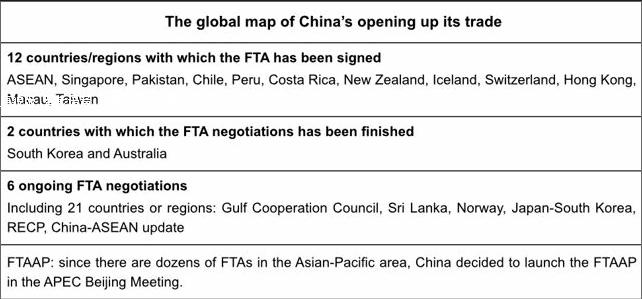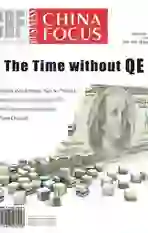Decipher China-Australia FTA
2015-03-10

Chinese president Xi Jinping had a meeting with Australian Prime Minister Tony Abbott in Canberra on November 17, after which the two announced the substantial end of the ChinaAustralia free trade agreement negotiation. This means after about 10 years efforts, the China-Australia free trade agreement negotiation finally came to a positive end.
China, the worlds second largest economy, is going to open its market to the Australian agricultural products and services, while Australia is going to ease the limitation over Chinese investment into its affluent resources. The agreement, which has the milestone significance, will bring about a lot of benefits to people and economic development of China and Australia in the next few years.
Australian agricultural products as the biggest beneficiary
According to the agreement, Australia is to lower the tariff rate for all products from China to zero, while China is to do the same thing to most of the Australian products. Among them, more than 85% of the products exported from Australia will enjoy the zero tariff rate immediately the agreement takes effect. The proportion is going to be increased to 93% in four years, and 95% of the Australian products is free of tariffs when the agreement is fully implemented.
The Australian agricultural products are apparently the biggest beneficiary. China and Australia are hugely different from each other in the development level of agriculture. Particularly, when the food safety problem is getting increasingly prominent in China, there will be more advantageous agricul- tural products to China with the nullification of tariffs.
For example, China is going to lower the tariff rate for dairy products from Australia to zero in four to eleven years. According to David Dukes, the Commerce Counselor in Australian Embassy in China, the exports volume from of dairy products from Australia to China has doubled from 2008 to 2013. Last year the exports volume reached Aus$351 million. At present, China imposes 10%-15% tariffs over the Australian dairy products. “The free trade agreement is certainly able to enhance competitive advantages of Australian dairy products and reduce its gap behind New Zealand which signed the FTA earlier than before. The baby and infant formula, as well as other major exported dairy products, are expected to have an increase in the exports volume.”
The same benefits will be felt by the other important exported agricultural products like beef, mutton, woolen and wine. David Dukes says that the exports volume of beef from Australia to China increased three- to fourfold in the past 12 months. In 2013 the total volume hit 153 thousand tons with the value of over Aus$700 million. China is going to eliminate the present 12%-25% tariffs over the beef imported from Australia. In addition, there are sources saying that the Australian wine is very likely to meet explosive development in China as the 14%-30% tariffs are going to be eliminated in four years, making Australian wine even likely to take the No. 1 place of French wine in China. Presently, the market share of French wine in China is around 40% while the Australian wine takes 17%.
David Dukes also believes that the exportation of Australian fruits and vegetables, which are now developing gradually in China, will be met with a large space for development. In addition, the seafood is also an important growth point. “For example, lobsters are now subject to the 15% tariff and it will be ended in four years. These products which were considered to be luxurious will have a more consumer-friendly price.”
However, the agricultural products take a small part in the Australian exports trade. The end of the tariffs therefore might have limited effect over the Australian economy. According to the data from Australian Department of Foreign Affairs and Trade, the exports volume contributed by Australian agricultural sector was only Aus$3.68 billion in 2013, taking 3.89% of the total exports volume of merchandise. Woolen is the biggest in quantity among all agricultural products Australia exports to China as the volume hit Aus1.9 billion. In comparison, the exports volume of iron ores was as high as Aus$52.65 billion.
The China-Australia Free Trade Agreement has made clear stipulations that the various resources and energy products are going to have the zero tariffs in the future. For example, the 8% tariff over the alumina, the 3% tariff over the charcoal, and the 6% tariff over the thermal coal are going to be eliminated within two years after the validation of the FTA. It is known that Australia is the largest coal exporter for China, as the latter imported 88 million tons of coal in 2013, taking 30% of the its total imports volume. In addition, half of the imported charcoal from China comes from Australia.
The iron ores, however, might have no luck with the finalization of FTA between China and Australia. This industry has already seen the zero tariff rate before the FTA. And the slowdown in Chinese economic growth, and the huge inventory of iron ores, coal and cotton in Chinese ports, have rendered the demand for Australian iron ores weak.
David Dukes believes that the FTA is very important for some resources to “lock the zero tariff rate”. “Thats because the present zero tariff rate without any guarantee of FTA might not last long in the future,” he says. “Though China now has no robust demand for various kinds of resources, the long-term vision is needed since the Northeast Asian countries, including China, are still important markets for Australian minerals. Australian mining companies are still very confident in the Chinese market.”
Breach points in access to service
Apart from the merchandise trade, the biggest break- throughs the FTA has made are the terms of market access. This is the first time that China fully and concretely wrote the opening-up of service industry in the FTA.
“The service industry takes the largest part in the Australian economy and is increasing its share in the Chinese economy. The two countries open the door of this sector to each other, which will have positive effect over their own economic development,” says David Dukes.
The terms concerning service industry includes: allowing Australian investors to set up 100% wholly-owned travel agencies, hotels, restaurants, real estate companies, environmental protection companies and R&D institutions in China, increasing the number of choices for overseas Chinese students, allowing Australian construction and design companies to undertake more and bigger projects in China, expanding the cooperation among lawyer firms, allowing Australian mining companies to provide more comprehensive mining services in Central and West China. In addition, Chinese service suppliers can enjoy the same treatments with the ones in the free trade agreement between Australia and South Korea and Japan.
In the financial sector in particular, the Chinese government made pledges in the transparency, governmental decision-making process and approval speed. In addition, on November 17, Peoples Bank of China and Reserve Bank of Australia (RBA) signed the memorandum of cooperation about setting up RMB liquidation in Australia. Meanwhile, the two countries banks have agreed to expand the pilot area of RQFII (RMB qualified foreign institutional investors) to Australia, and to increase the investment of RBA in the interbanking securities market of China.
David Dukes says that “Australia welcomes the internationalization of RMB. In 2013 the trade volume between China and Australia reached Aus$150 billion. If some of the trade activities can be settled with RMB, there will be great convenience for the enterprises of the two countries and could help them avoid the loss of multiple times of exchange settlement”. In truth, the establishment of RMB liquidation system in Australia is used for more than the trade settlement. With the increase of the bilateral investment, RMB is believed to play an important role in this process.
As some analysts have said, the Australians can benefit from the reduced tariffs for agricultural products and minerals, and the opening-up of the access to the service industry while the FTA would bring more benefits to its manufactur-ing. For example, the Australian government erased the tariffs over China-made apparels, shoes, automobile components, vehicles and electronic products which total 1 billion yuan. Through September 2014, the total imports volume of Australia from China amounted to US$20.76 billion, 61.8% of which was contributed by electronic products, textiles, furniture and toys.
Generally speaking, the FTA is good for the Chinese economy and will not bring about great impact to the industrial sectors in China. As Ma Zhaoxu, Chinese Ambassador in China, has pointed out, the Chinese and Australian economic structures are highly complementary with each other, providing a great space for the economic and trade cooperation between the two countries. The finalization of the FTA is good for further promoting the bilateral economic and trade relations for mutual benefits and win-win results.
Relax restrictions over investment
In the investment where China has a strong appeal, the FTA has the stipulations as follows: the Australian government will only conduct reviews and examinations of the investment from Chinese private enterprises if the volume is higher than Aus$1.078 billion, the same as Australians requirement for investors from other FTA-tied countries and much higher than the previous threshold of Aus$248 million. What left unchanged is the Aus$15-million cap of private investment in Australian farmland that triggers the Australian governments review. For the enterprises investment into agriculture, the cap still stays at Aus$53 million.
However, the investment made by Chinas state-owned enterprises is still subject to the reviews of Foreign Investment Review Bureau of Australia (FIRB) regardless of the volume.
David Dukes stresses that “most of the investment projects will not see the amount surpass the ceiling of Aus$1 billion. Therefore, they are no longer subject to the reviews In the past few years, most of the investment projects were approved by the FIRB while only a few were required to have additional conditions. In addition, Australians conduct reviews of all investment projects by state-owned enterprises from any foreign countries and this is not exclusive for China.” He says that the investment from China in Australia is not large in the volume and expects China to increase the investment into China.
The FTA between China and Australia is more than an international agreement. It is also a platform which designs an internal system, including the first review in three years. This will further promote the opening-up and expand of market access based on the equal and win-win situation of the two countries.
